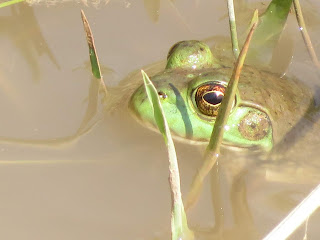This is a specialist lizard hunter. It's faster than anything but completely harmless to people. This one got caught out in the open ditch and is trying to hide by being a twig, (with big eyes)
This little gosling of a mallard duck is also trying to hide in the reeds. It's eyes are harder to see because of the dark stripe, so it blends in better than the snake did.
If this turtle didn't have such a large red stripe behind the head, it would look just like a mud covered log. The red is harder to see underwater, however.
This bullfrog is also able to blend into the plants, by being the same color as the stems, but again, those large copper colored eyes give it away. It has some ability to change the color of green.
The stripes on this lizard are awesome camouflage, but only in long grass stems with shadows. Out in the open, young lizards hold up their tails when they run, hoping that will prevent a predator from eating the rest of it. This is a form of distraction camouflage.
Muskrats are pretty good at holding still, and only come out during early morning. They can dive underwater, but they mostly stand out only when they make the water ripple.
Coopers hawks also prefer to hide by remaining motionless and hunting early morning. This one is getting a drink from the birdbath in the heat of the day. It is being heavily scolded by all the songbirds in the nearby bushes.
If this turtle didn't have such a large red stripe behind the head, it would look just like a mud covered log. The red is harder to see underwater, however.
This bullfrog is also able to blend into the plants, by being the same color as the stems, but again, those large copper colored eyes give it away. It has some ability to change the color of green.
The stripes on this lizard are awesome camouflage, but only in long grass stems with shadows. Out in the open, young lizards hold up their tails when they run, hoping that will prevent a predator from eating the rest of it. This is a form of distraction camouflage.
Muskrats are pretty good at holding still, and only come out during early morning. They can dive underwater, but they mostly stand out only when they make the water ripple.
Coopers hawks also prefer to hide by remaining motionless and hunting early morning. This one is getting a drink from the birdbath in the heat of the day. It is being heavily scolded by all the songbirds in the nearby bushes.
These plants are just about to put out their burrs. There are large stands of wild licorice (not sweet) along the disturbed ground next to shaded arroyos. They support skipper butterfly species
This flower is an aster species adapted to dry conditions, sometimes colorfully known as Mexican devilweed
A knapweed. Looking very, resplendently, unweedy. However, the roots produce a powerful plant poison that keeps other species from thriving near them.
Honeysuckle flowers smell very sweet on humid evenings, but they have such odd flowers shapes though. I haven't seen this plant feral, just in people's backyards.
This weird flower is some sort of sunflower species, but not the big ones we will see during the hottest months.
The antlions, damselflies and dragonflies all seem to be out early this year, but these things can be hard to judge. Their nymphs will not be easy to see for another month or so.This flower is an aster species adapted to dry conditions, sometimes colorfully known as Mexican devilweed
A knapweed. Looking very, resplendently, unweedy. However, the roots produce a powerful plant poison that keeps other species from thriving near them.
Honeysuckle flowers smell very sweet on humid evenings, but they have such odd flowers shapes though. I haven't seen this plant feral, just in people's backyards.
This weird flower is some sort of sunflower species, but not the big ones we will see during the hottest months.
The dragonfly eggs are only just being laid now. These are common green darners mating on a log. The male holds the female's head in a grip using claspers on the end of the abdomen until she is ready to lay the eggs.
Beetles are some of the weirdest insect species. These flat guys have a pattern on their carapace that looks a lot like a tortoise.
This common darkling beetle is warning me that it is capable to releasing a foul smelling liquid if touched. The headstand does not impress me, but seems to work on the noses of inquisitive dogs.
This moth is identified as a "Paler graphic" moth. The colors are quite striking for a family that is usually better known for being the drab cousins of the flashy butterflies.
Camouflage can be tricky, this young grasshopper would be invisible in cottonwood leaves. But under a moth light, it could not stand out more.
This fearsome face belongs to the giant scavenger beetle. It is one of the first predators to fly into new ephemeral pools often found beside roads. They and their newly hatched larva (water tigers) often diet on early tadpoles and eggs.



















No comments:
Post a Comment